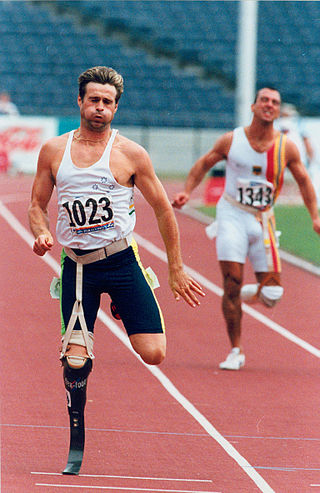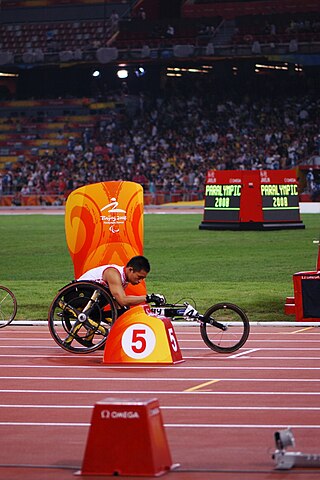S5, SB4, SM5 are disability swimming classifications used for categorizing swimmers based on their level of disability. The class includes people with a moderate level of disability, and includes people with full use of their arms and hands, but limited to no use of their trunk and legs. It also includes people with coordination problems. A variety of disabilities are represented by this class including people with cerebral palsy. The class competes at the Paralympic Games.

2 point player and 2.5 point player is a disability sport classification for wheelchair basketball. People in this class have partial trunk control when making forward motions. The class includes people with T8-L1 paraplegia, post-polio paralysis and amputations. People in this class handle the ball less than higher-point players. They have some stability issues on court, and may hold their wheel when trying to one hand grab rebounds.

4-point player is a disability sport classification for wheelchair basketball. Players in this class have normal trunk function but have a reduced level of functioning in one or both of their lower limbs. They may have difficulty with sideways movements. People in this class include ISOD classified A1, A2 and A3 players.

4.5-point player is a disability sport classification for wheelchair basketball. Players in this class tend to have normal trunk movement, few problems with side-to-side movements, and ability to reach to the side of their chair. Players generally have a below-knee amputation, or some other partial single-leg dysfunction. This classification is for players with minimal levels of disability. In some places, there is a class beyond this called 5-point player for players with no disabilities.
T32 is disability sport classification for track events in disability athletics. This is a wheelchair racing class. The classification is one of three classes of wheelchair racing for people with athetosis, ataxia or hypertonia. The number of events available to people in this class has decreased since the 1980s, with no T32 events at the 2016 Summer Paralympics. While undergoing classification, T32 competitors both undergo a bench test of muscle coordination and demonstrate their skills in athletics.
T33 and CP3 are disability sport classification for disability athletics. The class competes using a wheelchair. The classification is one of eight for people with cerebral palsy, and one of four for people with cerebral palsy who use a wheelchair. Athletes in this class have moderate quadriplegia, and difficulty with forward trunk movement. They also may have hypertonia, ataxia and athetosis.
T34 is a disability sport classification for disability athletics. The classification is one of eight specifically for athletes with cerebral palsy, and one of four for athletes with cerebral palsy who use a wheelchair. People in this class have hypertonia, ataxia and athetosis. This class includes people who have cerebral palsy, or who have had a stroke or traumatic brain injury.

T44 is a disability sport classification for disability athletics, applying to "Single below knee amputation or an athlete who can walk with moderately reduced function in one or both legs." It includes ISOD A4 and A9 classes.
T51 is disability sport classification for athletics. The class includes people with a number of different types of disabilities including spinal cord injuries and cerebral palsy. Similar classifications are T52, T53, T54 and T55. It is for sportspeople with minimal upper body function who use a wheelchair, spinal cord injury class F1 and Les Autres class LAF1.
T52 is disability sport classification for disability athletics. People in this class have good shoulder and upper body control, but lack fine motor skills in their arms and hands. They have no to limited trunk and leg function. The class includes people with a number of different types of disabilities including spinal cord injuries. Similar classifications are T51, T53 and T54.

T53 is disability sport classification for disability athletics. The class includes people with a number of different types of disabilities including spinal cord injuries. People in this class have full use of their arms but have no or limited trunk function. Similar classifications are T51, T52, and T54. People in this class have a functional upper limbs, but limited trunk usage and limited lower limb functionality. During classification, they both undergo a bench test of muscle strength and demonstrate their skills in athletics. People in this class include Tanni Grey-Thompson (GBR), Samantha Kinghorn (GBR), Angie Ballard (AUS) and Richard Colman (AUS).
Disability sports classification is a system that allows for fair competition between people with different types of disabilities.
F57 is a disability sport classification for disability athletics for people who compete in field events from a seated position. This class is for people with limb deficiencies not covered by other classes. It includes people who are members of the ISOD A1 and A9 classes. Events open to people in this class include the shot put, discus and javelin.
F56 is a disability sport classification for disability athletics for people who compete in field events from a seated position. The seating field event class used to be known as lower 4, upper 5. Different disability groups compete in this class, including people with amputations and spinal cord injuries. Events that may be on the program for F56 competitors include the discus throw, shot put and javelin.
F55 is a disability sport classification for disability athletics for people who compete in field events from a seated position. Sportspeople in this class have full arm function, partial trunk function and no lower limb function. Different disability groups compete in this class, including people with spinal cord injuries. The classification was previously known as lower 3, upper 4.
F2, also T2 and SP2, is a wheelchair sport classification that corresponds to the neurological level C7. Historically, it was known as 1B Complete, 1A Incomplete. People in this class are often tetraplegics. Their impairment effects the use of their hands and lower arm, and they can use a wheelchair using their own power.
F3, also T3 and SP3, is a wheelchair sport classification that corresponds to the neurological level C8. Historically, it was known as 1C Complete, and 1B Incomplete. F3 sportspeople have functional issues related to the muscles in their throwing arm, though they have enough control over their fingers to grip a throwing implement normally. They have no functional trunk control.
F4, also T4 and SP4, is a wheelchair sport classification that corresponds to the neurological level T1- T7. Historically, it was known as 1C Incomplete, 2 Complete, or Upper 3 Complete. People in this class have normal upper limb function, and functional issues with muscles below the nipple line.
Wheelchair sport classification is a system designed to allow fair competition between people of different disabilities, and minimize the impact of a person's specific disability on the outcome of a competition. Wheelchair sports is associated with spinal cord injuries, and includes a number of different types of disabilities including paraplegia, quadriplegia, muscular dystrophy, post-polio syndrome and spina bifida. The disability must meet minimal body function impairment requirements. Wheelchair sport and sport for people with spinal cord injuries is often based on the location of lesions on the spinal cord and their association with physical disability and functionality.
F54 is a disability sport classification for disability athletics for people who compete in field events from a seated position. Different disability groups compete in this class, including people with spinal cord injuries. Events that may be on the program for F54 competitors include the discus throw, shot put and javelin.








